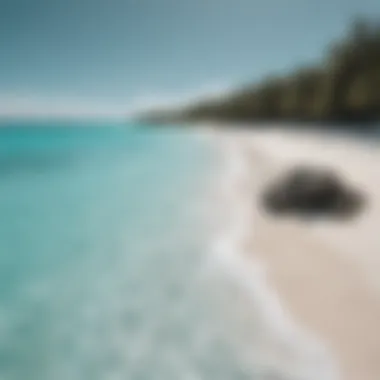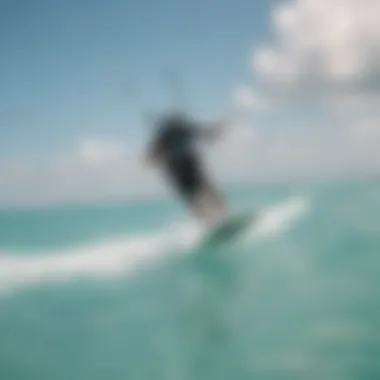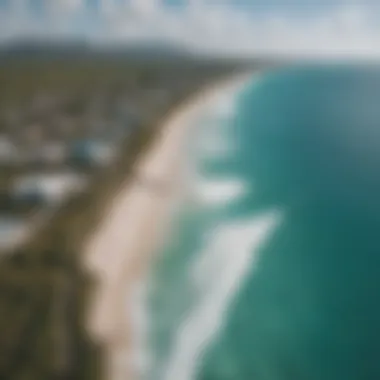Weather Insights and Beach Conditions in Turks and Caicos


Intro
Turks and Caicos, those jewels of the Caribbean, present not just idyllic vistas but also a lively climate that beckons beachgoers and thrill-seekers alike. The islands, with their stunning beaches, turquoise waters, and lush landscapes, are anything but ordinary. But if you’re planning a trip—especially if kiteboarding is on your agenda—understanding the weather dynamics is crucial. This guide digs into the atmospheric patterns and beach conditions, ensuring you make the most of your exploits in this tropical paradise.
The climate here generally falls under the warm and humid category, aligning perfectly with the tropical vibe that many travelers yearn for. However, it’s essential to be aware of the fine details to optimize your visit. With careful entry into the yearly climate patterns, we can pinpoint not just when the sunny days grace the shores but also when the winds reach their zenith, providing ideal conditions for kiteboarding.
Moreover, for those drawn to kiteboarding or simply lounging by the sea, knowing how to navigate the changing nuances of weather can spell the difference between a star-studded holiday and a soggy disappointment. So, whether you’re an experienced kiteboarder looking for that perfect gust or just venturing onto the sands for some well-deserved relaxation, it shoud be known that the weather holds the key to your experience here.
Let’s traverse the waters of information together, steering through the major points that embody the wonders of Turks and Caicos. We’ll touch base on the best times to visit, the seasonal variances in beach conditions, and practical tips that every sun-seeker should carry along in their travel arsenal.
In this exploration, travelers and adventurers will find not just practices but insight—a synthesis of experience and knowledge that can enhance your adventures on these stunning shores.
Understanding the Climate of Turks and Caicos
The climate in Turks and Caicos is more than just a backdrop for the stunning beaches and vibrant waters. It shapes the very experiences of visitors and locals alike. A clear grasp of this unique climate is essential for anyone planning to dive into the adventure of kiteboarding, relaxing on the sand, or exploring the islands. Understanding how weather affects everything from beach conditions to water clarity can make the difference between a memorable trip and one marked by unforeseen challenges.
The islands are located in the Caribbean, basking in a tropical maritime climate that boasts warm temperatures year-round, but it comes with its own quirks. Visitors might find themselves drawn to this paradisiacal locale not just for the sun-kissed beaches but also for the implications of its climate on their activities.
The Role of Tropical Weather Systems
Tropical weather systems significantly influence the climate and coastal activities in Turks and Caicos. The islands sit near the Caribbean Sea, making them susceptible to tropical storms and hurricanes, especially during the Atlantic hurricane season, which runs from June to November. One minute you might feel the gentle trade winds, and the next you could be on alert as a tropical storm heads your way.
These systems can produce wildly changing conditions. For kiteboarders, this means that while some days present perfect, calm waters, others might bring heavy swells and winds that could challenge even seasoned riders.
"Understanding the tropical patterns not only lays the groundwork for safe travels but also offers insight into unique riding conditions that can enhance your overall adventure."
Seasonal Variations
Transitioning through the seasons, the weather on the islands can shift dramatically, creating varied beach conditions. Winter months, for example, from December to February, tend to bring cooler temperatures and lower humidity, ideal for outdoor activities. As spring dances in, the warmth returns, inviting more tourists and enhancing water activities. But come summer, the heat ramps up, and so does the chance of sudden thunderstorms. Each season brings its character, affecting everything from what to pack to the best times for sports like kiteboarding.
Average Temperature Ranges
Average temperature ranges in Turks and Caicos can make or break your beach experience. The islands typically enjoy average temperatures around 80°F (27°C) year-round, but these averages conceal some fluctuations:
- Winter (December to February): Average highs around 76-78°F (24-26°C), perfect for those looking to escape colder climates.
- Spring (March to May): Temperatures start to rise, with averages hitting about 80-85°F (27-29°C). The delightful breeze makes it feel even more comfortable.
- Summer (June to August): Here, you'll experience average highs in the mid-80s°F (29-32°C); the humidity also spikes, leading to feel like temperatures exceeding 90°F (32°C) on particularly warm days.
- Fall (September to November): As summer fades, temperatures stay warm, averaging around 79-85°F (26-29°C), but keep an eye on developing storms.
Being attuned to these average ranges equips travelers with the knowledge to prepare adequately, whether it be choosing the right gear or selecting the best times for engaging in water sports.
Monthly Weather Breakdown
Understanding the monthly weather patterns of Turks and Caicos is crucial for those planning a trip, particularly for kiteboarders and beach lovers. The tropical charm of these islands brings various weather conditions that can significantly influence daily activities. Knowing the monthly variations can help travelers make informed decisions about when to visit, what to pack, and how to maximize their enjoyment during their stay.
January and February
The beginning of the year in Turks and Caicos is marked by comfortable temperatures averaging between 24°C to 27°C (75°F to 81°F). At this time, the islands experience dry season conditions, which means visitors are less likely to encounter rain. The lower humidity and light winds make it a perfect time for kiteboarding, especially for newbies looking to get their footing.
The sunny skies can make beaches seem almost to glisten, attracting both locals and tourists. The calm waters also create a more inviting environment for those willing to just lounge and soak up the sun. With daylight slowly stretching, January and February offer a balmy escape from colder climates.
March to May
As March rolls in, the temperatures rise slightly but remain manageable, usually fluctuating between 25°C to 28°C (77°F to 83°F). This period marks the transition to the spring months where conditions remain ideal for outdoor activities. With a combination of sunny days and gentle breezes, kiteboarding enthusiasts often find this time especially appealing.
By April and May, you’ll witness a palpable increase in tourist presence on the islands. Beaches fill with sun-seekers, and kiteboarding schools host many eager participants. Don’t be surprised by the occasional breeze, which can solidify kiteboarding as an exhilarating thrill.
June to August
Summer brings its unique flavor to Turks and Caicos. The months of June through August can boast higher temperatures, averaging around 27°C to 30°C (81°F to 86°F). However, this season comes with a caveat—the humidity levels rise considerably, turning the atmosphere a bit sticky.
The chances of rainfall also increase, particularly in August, which still comprises predominantly quick, passing showers. Kiteboarders may need to be on the lookout for changing weather patterns, as storm systems can brew in the Caribbean during this time. Regardless, many kiteboarding enthusiasts embrace the warmer temperatures and make the most of beach life. The lively atmosphere and vibrant sunsets remain unmatched.
September to December


The latter part of the year, particularly September and October, can be particularly tricky. This time falls squarely within the hurricane season, which spans from June 1st to November 30th. While hurricanes are not guaranteed, potential travelers should keep an eye on forecasts. The average temperature remains pleasant, around 25°C to 29°C (77°F to 84°F), making it still suitable for most activities if the weather behaves.
As the season transitions into November and December, the threats from hurricanes diminish significantly, and conditions clear up. This transition marks the beginning of the peak travel season. Visibility improves for water activities, enhancing the overall beach experience.
By understanding this monthly breakdown, travelers can craft their itineraries to enjoy the best of Turks and Caicos—whether it be gliding over the water with a kite or simply relaxing under the sun.
Beach Conditions Throughout the Year
Understanding the beach conditions throughout the year in Turks and Caicos is vital for anyone looking to throw themselves into water sports, particularly kiteboarding, or simply enjoying sun-soaked days on the sand. The beach experience can significantly vary based on several natural elements, such as wind, water clarity, and wave conditions. They are not just details; they affect everything from your itinerary to your overall enjoyment.
Optimal beach conditions often hinge on knowing the specifics of these elements. For kiteboarders, understanding how wind patterns change with seasons can be the difference between a thrilling ride and a frustrating day. Similarly, the transparency of water and its temperature impacts swimmers and snorkelers alike, determining the visibility of marine life and comfort levels during activities.
Wind Patterns and Their Impact
Wind is arguably the most crucial factor for kiteboarders in Turks and Caicos. The region experiences trade winds that provide consistent conditions. Generally, these winds blow from the east, and their strength can vary throughout the year. For instance, the peak wind season usually falls between November and April, making it prime time for kiteboarding enthusiasts.
When planning a trip, it's important to note how these winds can create different riding experiences on the beaches. On more open shorelines, strong winds can lead to choppy waters, presenting challenges for beginners. Alternatively, in sheltered spots like Long Bay Beach, conditions might remain relatively calm, providing a more forgiving environment for novice kiters.
Interestingly, kiteboarders also look for specific wind speeds. A steady breeze of 14 to 25 knots tends to be favorable, allowing for good height and speed without overwhelming those still honing their skills.
Water Clarity and Temperature
Next, let’s talk about the water clarity and temperature, essential factors for anyone keen on indulging in aquatic pastimes. The waters surrounding Turks and Caicos are remarkably clear, especially during the dry season. This clarity not only enhances the visual splendor but also offers excellent visibility for snorkelers and divers eager to explore vibrant coral reefs.
The temperature of the water hovers around 77°F (around 25°C) in the coldest months and can rise to a comfortable 85°F (about 29°C) in summer. This warmth adds to the appeal of water activities, allowing for prolonged enjoyment without the biting chill that can be found in less tropical climates.
Heat does have a downside, though. Prolonged exposure to the sun can lead to dehydration and heat-related illnesses. Thus, planning for hydration and skin protection becomes all the more crucial.
Wave Conditions for Kiteboarding
Wave conditions can have a decisive impact on kiteboarding, influencing not only the feasibility of riding but also the skill set required. Generally, the best waves for kiteboarding in Turks and Caicos can be found on the northern shores, especially around areas like Grace Bay Beach. Larger swells roll in during the hurricane season, particularly from mid-August to late October; however, this is not ideal for non-experienced kiters, as conditions can become unpredictable.
For those who enjoy the challenge of riding over waves, certain spots offer the thrill of peaking swells while still providing flat-water zones for more controlled practice sessions. Recognizing where to go for the conditions suited to your skill level is essential.
"Whether you crave the thrill of kiteboarding or the tranquility of an afternoon swim, understanding beach conditions can shape your entire experience in Turks and Caicos."
In summary, being mindful of beach conditions throughout the year can transform an ordinary holiday into an extraordinary adventure. Kiteboarders and beach-goers alike should stay attuned to the winds, water clarity, and wave patterns to ensure their trip to these picturesque islands is as enjoyable as possible.
Best Beaches for Kiteboarding
When it comes to kiteboarding in Turks and Caicos, the choice of beach can make all the difference. Kiteboarding is not just a fun activity—it’s an adrenaline-fueled experience where wind and water converge, and the right beach can enhance that thrill tenfold. Each beach has its unique conditions and charms, and understanding these elements is crucial for every kiteboarder, whether you're just starting out or have been flying across the waves for years.
Grace Bay Beach
Grace Bay Beach is often touted as one of the crown jewels of the Caribbean. Its vibrant turquoise waters and powdery white sands do more than just look picturesque; they create optimal conditions for kiteboarding. The beach benefits from consistent wind patterns that entice adventurers from all corners of the globe.
One important aspect to note is that the eastern end of Grace Bay can provide an ideal spot for beginners. With shallow waters and less challenging wave conditions, newcomers to the sport can safely practice their skills without feeling overwhelmed.
Moreover, Grace Bay is well-equipped with local kiteboarding schools like Kite Provo, where experienced instructors can show you the ropes. Joining a lesson here can dramatically enhance your skill level in no time.
"A perfect balance of fun and safety, Grace Bay Beach is where many kiteboarders start their journey."
Long Bay Beach
On the other side of the island lies Long Bay Beach, which has earned a reputation for its expansive stretch of sand and steady winds. This beach is frequently less crowded than Grace Bay, making it a haven for kiteboarders seeking ample space to maneuver. The breezy environment encourages more advanced techniques, making it a favorite among those who are ready to push their limits.
It's also worth mentioning that Long Bay is particularly famous for its warm, shallow waters which create conditions that allow riders to practice jumps and tricks with safety. If you get lucky, you might even spot a wild stingray gliding just beneath the surface.
Sapodilla Bay
Lastly, there's Sapodilla Bay, a hidden gem for kiteboarding enthusiasts. Often less frequented compared to the other two beaches, it offers a more tranquil experience. Here, the waters are calm and shallow, making it suitable not just for seasoned kiteboarders but also for families looking to enjoy a day at the beach.
The prevailing winds in this area tend to be gentle, which works in the favor of both beginners and those looking for a relaxing kiting session. With the setting sun casting a golden hue on the waters, kiteboarding here can feel like traversing through a dreamscape. Furthermore, the sunsets here can be nothing short of enchanting, providing a perfect way to wind down after a day of excitement.


In summary, choosing the right beach for kiteboarding is crucial for maximizing your enjoyment and safety. Each beach offers its unique flavor of wind and water dynamics, catering to different skill levels while also ensuring an exquisite experience against the backdrop of the stunning landscape of Turks and Caicos.
Key Considerations for Travelers
Planning a trip to Turks and Caicos, especially for those keen to take to the waves, involves more than just picking up a suitcase and hopping on a plane. Understanding the nuances of weather and environmental factors can elevate an ordinary vacation into an extraordinary adventure. This section looks at the vital aspects that travelers should consider when venturing to these stunning islands, guiding kiteboarders, beach lovers, and adventurers alike.
Choosing Your Travel Dates
Choosing the right travel dates is paramount, particularly for kiteboarding enthusiasts. The peak season runs from December through April, where sunny skies and pleasant winds create ideal conditions. However, this period also sees the biggest crowds and higher accommodation prices. If you're looking for a deal and still want fun offshore breezes, visiting just before or after this peak season—November or May—might just be your golden ticket.
- Weather Patterns: Generally, January offers consistent trade winds, perfect for kiteboarding. The winds tend to lighten in June, which could affect performance, especially for beginners.
- Events and Festivals: The islands host various festivals throughout the year; the Conch Farm Festival in November or the Food and Wine Festival in November can be entertaining additions to your itinerary.
- Hurricane Season Awareness: Pay attention to weather forecasts from June to November as hurricanes can impact travel plans.
Packing for the Weather
Packing right for Turks and Caicos is a mix of being practical and staying stylish. The tropical climate means warm temperatures, but understanding the local nuances will make for a more comfortable experience.
- Light, Breathable Clothing: It’s generally warm, so materials like cotton or linen can help keep you cool. Vibrant swimsuits and casual beachwear are not just comfortable but also align with the local vibe.
- Kiteboarding Gear: If you’re serious about kiteboarding, bringing your gear could enhance your experience. Packing tips include:
- Sun Protection: Bring a high SPF sunscreen, sunglasses, and a hat to shield yourself from the sun's strong rays.
- Kite: Choose according to wind conditions, opting for a smaller size in high wind.
- Board: A smaller board can give you better control.
- Accessories: Don’t forget the pump, safety leash, and repair tools. It can save you some headaches!
Local Weather Resources
Information is power, especially when it comes to staying one step ahead of changing weather conditions. Utilizing local resources can greatly enhance your kiteboarding experience in Turks and Caicos.
- Online Weather Services: Websites such as Weather.com or AccuWeather provide detailed forecasts, including wind speeds and wave conditions, which are essential for kiteboarders.
- Local Kiteboarding Schools: Engaging with local instructors can offer insights into real-time conditions. They often have the latest updates on winds and local weather trends.
- Mobile Apps: Consider downloading wind and weather tracking apps like Windy or Kitesurfing Apps. They can assist you in making quick decisions about when and where to kiteboard, ensuring maximum enjoyment.
Using reliable resources will enable you to surf the winds and avoid the storms, ensuring your adventure remains an exhilarating ride.
Adverse Weather Conditions
Understanding adverse weather conditions is crucial for anyone planning a trip to Turks and Caicos, especially kiteboarders. The islands, while mostly blessed with beautiful weather, are not immune to storms and other unpredictable elements. Knowing how different weather patterns could affect your experience can be the difference between a wonderful adventure and an unexpected inconvenience.
Hurricane Season Overview
The hurricane season in Turks and Caicos spans from June 1st to November 30th. During these months, the region faces the possibility of tropical storms and hurricanes, which can lead to rough seas and extreme weather. It's a time when the otherwise serene beaches can transform into battlegrounds for fierce winds and rain.
Local residents and society have adjusted to these seasonal fluctuations. When will you visit? If it's during this period, it's smart to keep an eye on weather forecasts.
- Storm Formation: Most hurricanes develop from tropical waves. As these systems gather heat and moisture, they can quickly escalate into dangerous storms.
- Historical Impact: Previous years have shown that hurricanes, like Hurricane Ike in 2008, have left sizable impacts on the islands. Lessons learned from past storms have fortified the community's resilience and preparedness tactics.
"In the face of nature's fury, preparation is your best shield."
How to Stay Prepared
Preparation is the name of the game when traveling during hurricane season. The best approach is to arm yourself with knowledge and a well-thought-out plan:
- Stay Informed: Follow local news outlets or weather websites. Utilize apps to receive real-time updates on impending storms.
- Flexible Booking: When booking your accommodations, look for hotels or rental properties with flexible cancellation policies. This way, if a storm is on the horizon, you have options to adjust your plans.
- Emergency Kit: Consider packing a small emergency kit with essentials such as flashlights, batteries, and non-perishable food. Though it may feel odd, having these on hand can prove beneficial in case of power outages.
Cancellation Policies for Travel
When booking trips, every traveler should pay careful attention to cancellation policies, particularly during hurricane season. Here are critical aspects to consider:
- Refundable Tickets: Opt for airlines that offer full refunds or no-penalty changes. In situations where flights might be canceled or delayed due to harsh weather, having refundable tickets can ease the stress.
- Accommodation Flexibility: Choose lodgings with policies that allow changes to dates without heavy penalties. Emerging weather conditions can shift travel plans on a dime.
- Travel Insurance: Investing in travel insurance is a wise decision. Policies that include coverage for natural disasters help protect your investment. Make sure to understand the terms; some policies may not cover everything under the weather-related provisions.
In summary, understanding adverse weather conditions in Turks and Caicos—especially regarding the hurricane season—can significantly enhance safety and preparation. This information serves as a guide for both novice travelers and seasoned kiteboarders, ensuring their experience remains as seamless as possible.
Cultural and Environmental Impact of Weather
Understanding the relationship between weather and culture in Turks and Caicos is vital for anyone looking to explore these beautiful islands more deeply. The island's weather patterns seldom take a back seat; they actively shape what locals do, how they interact with their surroundings, and the economic activities they pursue. Additionally, the environment reacts to weather changes, influencing everything from tourism to agriculture.
Effects on the Local Ecosystem


The local ecosystem in Turks and Caicos—home to stunning coral reefs and diverse marine life—responds sensitively to shifting weather conditions. For instance, heavy rains can lead to fresh water runoff, which temporarily disrupts coral health, affecting the marine species that rely on coral reefs for habitat and food.
Moreover, rising sea temperatures attributed to climate change have been noted in the region, leading to coral bleaching events that can devastate underwater biodiversity. To illustrate, during a study in 2020, scientists observed that certain coral populations near the shores of Provo showed signs of stress due to fluctuating temperatures, a direct consequence of prolonged warm weather.
These environmental shifts further impact local fisheries, as some species may migrate in search of more favorable conditions, affecting the food chain and the livelihood of local fishers.
Community Adaptations
Communities in Turks and Caicos are not merely passive observers of weather changes. They've adapted in remarkable ways to cope with shifting patterns through resourcefulness and innovation. An example is the construction techniques that have evolved over the years. Homes are often built on stilts, a traditional method that protects from flooding during rainy seasons or hurricanes.
Moreover, the local fishing community actively engages in rotating fishing areas to minimize the impact on over-exploited zones, adapting their practices based on weather forecasts and fish activity patterns. For visitors, this means experiencing a community that is resilient and adaptive, showcasing their unique relationship with the land and sea.
Sustainable Tourism Practices
The tourism industry in Turks and Caicos increasingly emphasizes sustainable practices due to the region's delicate ecosystem. Tour operators are actively engaging in environmentally-conscious practices, like beach clean-ups and coral restoration programs, to raise awareness and reduce the impacts of tourism.
Furthermore, many resorts aim to educate tourists about the local flora and fauna, offering guided tours that highlight the importance of preserving natural habitats. As visitors, kiteboarders and adventurers can also integrate sustainable habits into their travels—things like using reef-safe sunscreen and supporting local businesses.
"Embracing sustainable tourism not only protects our environment but also enriches the traveler’s experience by connecting them to the local culture and landscapes in a meaningful way."
This synergy between cultural practices and environmental stewardship illustrates how weather impacts local lifestyles, driving both community adaptations and sustainable practices. Understanding these deeper layers not only enhances your adventure in Turks and Caicos but also builds respect for the delicate interplay between its enchanting weather and vibrant culture.
Connecting Weather with Kiteboarding Performance
Understanding how weather impacts kiteboarding is not just crucial; it's fundamental for anyone looking to embrace this thrilling sport in Turks and Caicos. Kiteboarding is deeply intertwined with meteorological conditions, and recognizing the nuances can significantly enhance the experience. From wind speeds to water temperature, every aspect of the environment plays a role in determining the feasibility and enjoyment of kiteboarding.
When we talk about kiteboarding, wind conditions are of paramount importance. The strength, consistency, and direction of the wind can dictate not only the safety of the activity but also its overall enjoyment. Therefore, kiteboarders must prioritize weather awareness when planning their sessions on the water. This awareness can translate to better performance, fewer accidents, and increased satisfaction on the waves.
Moreover, adapting to the weather of Turks and Caicos means understanding local patterns. The islands can exhibit unique climate behaviors, which might be unfamiliar to those from different regions. Thus, having a grasp on these elements aids not just in choosing the right gear but also in timing sessions for optimal performance.
Optimal Wind Conditions for Beginners
For those just starting their kiteboarding journey, grasping the winds can feel like learning a foreign language. However, Turks and Caicos offers wind conditions that are quite favorable. Generally, wind speeds between 15 to 25 knots are ideal for beginners. At these speeds, learners can feel secure, maintaining control over their boards and kites without being overwhelmed.
When opting for a spot, already knowing where to find the right wind is half the battle. Long Bay Beach and Grace Bay are well known for their consistent winds, making them fabulous places for newcomers. It's also worth noting that winds are typically stronger from the northeast during the winter months, thus offering even better training conditions.
Things to observe:
- Wind direction: It's best if the wind is coming onshore, providing a safe environment.
- Consistency: Watch for how steady the wind is. Fluctuating conditions can lead to difficulties, especially for novices.
- Local factors: Familiarize yourself with obstacles like trees or buildings that could affect wind flow.
In Turks and Caicos, beginners can practice in lighter winds to build their confidence before progressing to stronger gusts. A smart approach ensures not only safety but an enriched learning process.
Advanced Techniques and Weather Interpretation
Once a kiteboarder has honed basic skills, delving deeper into weather conditions becomes essential. Advanced kiteboarders must learn to interpret not just the wind but also atmospheric and oceanic patterns. Having this knowledge can lead to distinctly more thrilling experiences.
For those ready to elevate their skills, here are some advanced considerations:
- Analyzing Forecasts: Understand how to read marine forecasts and wind maps. Websites like Windy can be particularly helpful for real-time data.
- Wind Layer Dynamics: Professionals often study layers of wind at different heights. Knowing how these interact can reveal perfect launching windows.
- Local Weather Phenomena: Conditions can vary sharply in coastal areas. Watching out for microclimates can reveal the best times to hit the water.
A key takeaway for advanced kiteboarders is that anticipatory skills can change the game. Instead of reacting to conditions, skilled kiteboarders can foretell incoming weather changes, adjusting their courses and techniques accordingly.
"Being prepared to adapt is what separates the novice from the expert. The ocean speaks, and it’s wise to listen."
In summary, whether you're just starting or are a seasoned pro, connecting the dots between weather knowledge and kiteboarding performance is essential for maximizing your time in the stunning waters of Turks and Caicos. Winds tell a story, and for kiteboarders, every session can be a thrilling chapter awaiting to be written.
Epilogue
Wrapping up our exploration of the weather and beaches in the Turks and Caicos reveals the intricate dance between nature and recreation. Understanding weather patterns is not just a trivial detail; it's essential for making the most of your kiteboarding experience or simply soaking up the sun on those pristine sands. The nuances of the climate, from tropical storms to seasonal variations, play a vital role in shaping beach conditions and water clarity, impacting every aspect of outdoor activities.
Recap of Key Takeaways
- Tropical Climate: The weather in Turks and Caicos is primarily warm and tropical, making it inviting for most of the year. However, it’s crucial to be aware of seasonal variations and the hurricane season.
- Kiteboarding Conditions: Optimal wind and water conditions vary. Beginners may prefer the steadiness found in the spring months, while seasoned kiteboarders could savor the challenges present in summer.
- Impact of Weather on the Environment: Weather influences not just the watersports community but also the local ecosystem. Recognizing this connection fosters a greater appreciation for the environment and encourages responsible tourism practices.
- Essential Preparations: Travelers must consider packing strategies, travel dates, and local resources to stay informed about shifting weather patterns. Having the right gear and knowledge can make a world of difference in one's experience.
Final Advice for Enthusiasts
For those planning an adventure to Turks and Caicos, keep in mind that preparation is key. Researching the specific beaches where you intend to kiteboard can also pay dividends. Equip yourself with current weather forecasts from reliable sources. Gale warnings can crop up quick, so staying informed helps in avoiding any hiccups in your plans.
In addition, engage with the local kiteboarding community through platforms like Reddit or local Facebook groups to get real-time tips and firsthand experiences from those who share your passion. Embrace nature’s unpredictability, respect the local surroundings, and your time in this beautiful archipelago is sure to be unforgettable.















